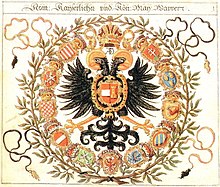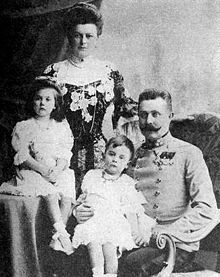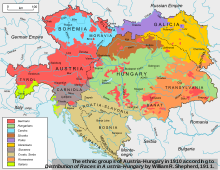ਆਸਟਰੀਆ
ਆਸਟਰੀਆ ਗਣਰਾਜ Republic of Austria Republik Österreich | |||||
|---|---|---|---|---|---|
| |||||
| ਐਨਥਮ: ਲੈਂਡ ਡੇਰ ਬਰਜ, ਲੈਂਡ ਆਮ ਸਟ੍ਰੋਮ (ਜਰਮਨ) ਪਹਾੜਾ ਵਾਲਾ ਦੇਸ਼, ਨਦੀਆਂ ਤੇ ਬਣਿਆਂ ਦੇਸ਼ | |||||
![Location of ਆਸਟਰੀਆ (dark green) – in Europe (light green & dark grey) – in the European Union (light green) – [Legend]](http://upload.wikimedia.org/wikipedia/commons/thumb/9/9d/EU-Austria.svg/250px-EU-Austria.svg.png) Location of ਆਸਟਰੀਆ (dark green) – in Europe (light green & dark grey) | |||||
| ਰਾਜਧਾਨੀ | ਵੀਆਨਾ | ||||
| ਸਭ ਤੋਂ ਵੱਡਾ ਸ਼ਹਿਰ | ਵੀਆਨਾ (Vienna) | ||||
| ਅਧਿਕਾਰਤ ਭਾਸ਼ਾਵਾਂ | ਜਰਮਨ, ਅਤੇ ਹੋਰ ਸਲੋਵੇਨ, ਕਰੋਛੀਅਨ ਅਤੇ ਹੰਗਰੀ | ||||
| ਵਸਨੀਕੀ ਨਾਮ | Austrian | ||||
| ਸਰਕਾਰ | ਫੈਡਰਲ ਪਾਰਲੀਮੈਂਟਰੀ ਗਣਰਾਜ | ||||
| Alexander Van der Bellen | |||||
| Sebastian Kurz | |||||
| ਆਜਾਦੀ | |||||
27 ਜੁਲਾਈ 1955 (Duchy: 1156, ਆਸਟਰੀਆ ਰਾਜਸ਼ਾਹੀ: 1804, ਆਸਟਰੀਆ ਦਾ ਪਹਿਲਾ ਗਣਰਾਜ: 1918−1938, ਦੁਜਾ ਗਣਰਾਜ 1945 ਤੋਂ) | |||||
| ਖੇਤਰ | |||||
• ਕੁੱਲ | 83,872 km2 (32,383 sq mi) (115th) | ||||
• ਜਲ (%) | 1.7 | ||||
| ਆਬਾਦੀ | |||||
• 2020 ਅਨੁਮਾਨ | 8,902,600 (92nd) | ||||
• 2001 ਜਨਗਣਨਾ | 8,032,926 | ||||
• ਘਣਤਾ | 106/km2 (274.5/sq mi) (106th) | ||||
| ਜੀਡੀਪੀ (ਪੀਪੀਪੀ) | 2008 ਅਨੁਮਾਨ | ||||
• ਕੁੱਲ | $328.571 billion[1] (34th) | ||||
• ਪ੍ਰਤੀ ਵਿਅਕਤੀ | $39,634[1] (12th) | ||||
| ਜੀਡੀਪੀ (ਨਾਮਾਤਰ) | 2008 ਅਨੁਮਾਨ | ||||
• ਕੁੱਲ | $415.321 billion[1] (23rd) | ||||
• ਪ੍ਰਤੀ ਵਿਅਕਤੀ | $50,098[1] (12th) | ||||
| ਗਿਨੀ (2000) | 29.1 ਘੱਟ | ||||
| ਐੱਚਡੀਆਈ (2008) | Error: Invalid HDI value · 14th | ||||
| ਮੁਦਰਾ | Euro (€) ² (EUR) | ||||
| ਸਮਾਂ ਖੇਤਰ | UTC+1 (CET) | ||||
• ਗਰਮੀਆਂ (DST) | UTC+2 (CEST) | ||||
| ਕਾਲਿੰਗ ਕੋਡ | 43 | ||||
| ਇੰਟਰਨੈੱਟ ਟੀਐਲਡੀ | .at ³ | ||||
| |||||
ਆਸਟਰੀਆ (ਅੰਗਰੇਜੀ: Austria ਅਤੇ ਜਰਮਨ: Österreich) ਯੂਰਪ ਦਾ ਇੱਕ ਦੇਸ਼ ਹੈ। ਇਸ ਦੀ ਰਾਜਧਾਨੀ ਵਿਆਨਾ ਹੈ। ਇਹ ਚਾਰੇ ਪਾਸੇਓਂ ਬਾਕੀ ਦੇਸ਼ਾਂ ਨਾਲ ਘਿਰਿਆ ਹੈ ਅਤੇ ਇਸ ਨਾਲ ਕੋਈ ਦੀ ਸਮੁੰਦਰ ਨਹੀਂ ਲੱਗਦਾ। ਉੱਤਰੀ ਦਿਸ਼ਾ ਤੋਂ ਇਸ ਦੇ ਨਾਲ ਜਰਮਨੀ ਅਤੇ ਚੈੱਕ ਰਿਪਬਲਿਕ, ਪੂਰਬੀ ਦਿਸ਼ਾ ਤੋਂ ਸਲੋਵਾਕੀਆ ਅਤੇ ਹੰਗਰੀ, ਦੱਖਣੀ ਦਿਸ਼ਾ ਤੋਂ ਸਲੋਵੇਨੀਂਆਂ ਅਤੇ ਇਟਲੀ, ਅਤੇ ਪੱਛਮੀ ਦਿਸ਼ਾ ਤੋਂ ਸਵੀਟਜ਼ਰਲੈਂਡ ਲੱਗਦੇ ਹਨ।
ਆਸਟਰੀਆ ਦੇ ਨੌਂ ਰਾਜ ਹਨ, ਅਤੇ ਇਹ ਯੂਰਪੀਅਨ ਯੂਨੀਅਨ ਦੇ 6 ਦੇਸ਼ਾਂ ਵਿੱਚੋਂ ਹਨ ਜਿਹਨਾਂ ਨੇ ਅੱਗੇ ਤੋਂ ਕਿਸੇ ਵੀ ਲੜਾਈ ਵਿੱਚ ਹਿਸਾ ਨਾਂ ਲੈਣ ਦੀ ਘੋਸ਼ਣਾ ਕਿਤੀ ਹੈ। ਆਸਟਰੀਆ 1955 ਤੋਂ ਯੂਨਾਈਟਡ ਨੇਸ਼ਨ ਦਾ ਮੈਂਬਰ ਹੈ, ਅਤੇ 1995 ਵਿੱਚ ਯੂਰੋਪੀਅਨ ਯੂਨੀਅਨ ਮੈਂਬਰ ਬਣਿਆਂ।
ਇਤਿਹਾਸ
[ਸੋਧੋ]ਇਸ ਲੇਖ ਨੂੰ ਪੰਜਾਬੀ ਵਿੱਚ ਤਰਜਮਾ ਚਾਹੀਦਾ ਹੈ। ਇਸ ਲੇਖ ਪੰਜਾਬੀ ਤੋਂ ਬਿਨਾਂ ਹੋਰ ਭਾਸ਼ਾ ਵਿੱਚ ਲਿਖਿਆ ਗਿਆ ਹੈ। ਜੇਕਰ ਇਹ ਉਸ ਭਾਸ਼ਾ ਦੇ ਭਾਈਚਾਰੇ ਦੇ ਪਾਠਕਾਂ ਲਈ ਹੈ, ਤਾਂ ਇਸ ਨੂੰ ਉਸ ਭਾਸ਼ਾ ਵਿੱਚ ਵਿਕੀਪੀਡੀਆ ਵਿੱਚ ਯੋਗਦਾਨ ਦਿੱਤਾ ਜਾਣਾ ਚਾਹੀਦਾ ਹੈ। ਕਿਰਪਾ ਕਰਕੇ ਚਰਚਾ ਲਈ ਅੰਗਰੇਜ਼ੀ ਵਿੱਚ ਅਨੁਵਾਦ ਦੀ ਲੋੜ ਵਾਲੇ ਪੰਨਿਆਂ 'ਤੇ ਇਸ ਲੇਖ ਦੀ ਐਂਟਰੀ ਦੇਖੋ। ਜੇਕਰ ਅਗਲੇ ਦੋ ਹਫ਼ਤਿਆਂ ਵਿੱਚ ਲੇਖ ਨੂੰ ਅੰਗਰੇਜ਼ੀ ਵਿੱਚ ਦੁਬਾਰਾ ਨਹੀਂ ਲਿਖਿਆ ਗਿਆ ਤਾਂ ਇਸਨੂੰ ਮਿਟਾਉਣ ਲਈ ਸੂਚੀਬੱਧ ਕੀਤਾ ਜਾਵੇਗਾ ਅਤੇ/ਜਾਂ ਇਸਦੀ ਮੌਜੂਦਾ ਭਾਸ਼ਾ ਵਿੱਚ ਵਿਕੀਪੀਡੀਆ ਵਿੱਚ ਭੇਜ ਦਿੱਤਾ ਜਾਵੇਗਾ। If you have just labeled this article as needing translation, please add {{subst:uw-notpunjabi|1=ਆਸਟਰੀਆ}} ~~~~on the talk page of the author. |
ਜਿਥੇ ਅੱਜ ਆਸਟਰੀਆ ਹੈ, ਉਥੇ ਪੁਰਾਣੇ ਸਮੇਂ ਵਿੱਚ ਸੇਲਟੀਕ ਕਬੀਲੇ ਰਹਿੰਦੇ ਸਨ। ਬਾਅਦ ਵਿੱਚ ਇਹ ਹਿਸਾ ਰੋਮਨ ਸਾਮਰਾਜ ਦੇ ਥੱਲੇ ਆ ਗਿਆ ਅਤੇ ਇਸ ਦਾ ਇੱਕ ਹਿਸਾ ਬਣ ਗਿਆ। ਜਦੋਂ ਰੋਮਨ ਸਾਮਰਾਜ ਦੀ ਸਮਾਪਤੀ ਹੋ ਗਈ, ਉਸ ਤੋਂ ਬਾਅਦ ਇੱਥੇ ਬਾਵੇਰੀਅਨ, ਸਲਾਵ, ਅਤੇ ਏਵਾਰਜ਼ ਇੱਥੇ ਆ ਕੇ ਟਿਕ ਗਏ।[2] ਸਲਾਵ ਏਲਪਜ਼ ਦੇ ਖੇਤਰ ਵਿੱਚ ਚਲੇ ਗਏ ਅਤੇ ਇੱਥੇ ਕੇਕੇਨਟੇਨੀਆਂ ਨਾਂ ਦਾ ਰਾਜ ਬਣਾਇਆ (ਇਹ ਆਸਟਰੀਆ ਦੇ ਪੂਰਬੀ ਅਤੇ ਗਬਲੇ ਹਿਸੇ ਵਿੱਚ ਸੀ)।

ਜਦੋਂ ਚਾਰਲਮੇਗਨ ਨੇ 788 ਨੂੰ ਇਹ ਖੇਤਰ ਤੇ ਕਬਜ਼ਾ ਕਿਤਾ ਤਾਂ ਇੱਥੇ ਇਸਾਈ ਧਰਮ ਫੇਲਾਇਆ ਅਤੇ ਉਪਨਿਵੇਸ਼ਣ ਨੂੰ ਉਤਪੰਨ ਕਿਤਾ।[2] ਪੂਰਬੀ ਫਰੈਂਸਿਆ ਦਾ ਹਿਸਾ, ਜਿਥੇ ਅੱਜ ਆਸਟਰੀਆ ਹੈ, ਇਹ ਖੇਤਰ 976 ਵਿੱਚ ਬੇਬਨਬਰਗ ਦੇ ਲਿਓਪੋਲਡ ਨੂੰ ਦੇ ਦਿੱਤਾ ਗਿਆ ਸੀ।[3] ਤੇ 976 ਤੋਂ 1246 ਤੱਕ ਬੇਬਨਬਰਗ ਰਾਜਕੁਲ ਨੇ ਆਸਟਰੀਆ ਦੇ ਖੇਤਰ ਤੇ ਰਾਜ ਕਿਤਾ। 1246 ਵਿੱਚ ਬੇਬਨਬਰਗ ਰਾਜਕੁਲ ਖਤਮ ਹੋ ਗਿਆ ਸੀ।[4] ਇਸ ਤੋਂ ਬਾਅਦ ਬੋਹੀਮਿਆਂ ਦੇ ਓਟਾਕਰ 2 ਨੇ ਆਸਟਰੀਆ ਤੇ ਕਬਜ਼ਾ ਕਰ ਲਿਆ।[4] ਅਤੇ ਫਿਰ 1278 ਵਿੱਚ ਜਰਮਨ ਦੇ ਰੂਡੋਲਫ਼ 1 ਨੇ ਇੱਕ ਜੰਗ ਵਿੱਚ ਓਟਾਕਰ 2 ਨੂੰ ਹਰਾਇਆ ਅਤੇ ਆਸਟਰੀਆ ਤੇ ਕਬਜ਼ਾ ਕਿਤਾ।[5] ਇਸ ਤੋਂ ਬਾਅਦ ਰੂਡੋਲਫ਼ 1 ਨੇ ਹੈਬਜ਼ਬਰਗ ਰਾਜਕੁਲ ਦੀ ਸ਼ੁਰੂਆਤ ਕਿਤੀ। ਹੈਬਜ਼ਬਰਗ ਰਾਜਕੁਲ ਫਿਰ ਆਸਟਰੀਆ ਦੇ ਇਤਿਹਾਸ ਵਿੱਚ ਪਹਿਲੇ ਵਰਲਡ ਵਾਰ ਤੱਕ ਰਿਹਾ।
14ਵੀਂ ਅਤੇ 15ਵੀਂ ਸਦੀਆਂ ਵਿੱਚ ਹੈਬਜ਼ਬਰਗਾਂ ਨੇ ਆਪਣਾ ਰਾਜ ਵਧਾਉਣ ਲਈ ਆਸਟਰੀਆ ਦੇ ਨਾਲ ਲੱਗਦੇ ਇਲਾਕੇਆਂ ਆਪਣੇ ਰਾਜ ਵਿੱਚ ਮਿਲਾਉਣ ਲੱਗ ਪਏ। ਸੰਨ 1477 ਵਿੱਚ ਆਰਚਡੂਕ ਮੇਕਸੀਮਿਲੀਅਨ ਨੇ ਬਰਡੰਗੀ (ਜਿਥੇ ਅੱਜ ਨੇਦਰਲੈਂਡ (ਹਾਲੈਂਡ)) ਦੀ ਰਾਜਕੁਮਾਰੀ ਨਾਲ ਵਿਆਹ ਕਰ ਕੇ ਪੂਰਾ ਰਾਜ ਹੈਬਜ਼ਬਰਗ ਰਾਜਕੁਲ ਦੇ ਰਾਜ ਵਿੱਚ ਮਿਲਾਇਆ।[6][7] ਮੇਕਸੀਮਿਲੀਅਨ ਦੇ ਲੜਕੇ ਫਿਲੀਪ 1 ਨੇ ਫਿਰ ਕੇਸਟਾਇਲ ਅਤੇ ਐਰਾਗਾਨ ਦੀ ਉੱਤਰਾਧਿਕਾਰਨ ਨਾਲ ਵਿਆਹ ਕਰ ਕੇ ਸਪੈਨ ਅਤੇ ਇਸ ਦੇ ਇਟਾਲੀਆਨ, ਅਫ਼ਰੀਕਨ, ਅਤੇ ਉੱਤਰੀ ਅਤੇ ਦੱਖਣੀ ਅਮਰੀਕਾ ਦੇ ਖੇਤਰ ਵੀ ਹੈਬਜ਼ਬਰਗ ਰਾਜਕੁਲ ਦੇ ਰਾਜ ਵਿੱਚ ਮਿਲਾਇਆ।[6][7] ਸੰਨ 1526 ਵਿੱਚ ਮੋਹਾਕਸ ਦੀ ਲੜਾਈ ਦੇ ਬਾਅਦ, ਬੋਹੀਮੀਆਂ ਅਤੇ ਹੰਗਰੀ ਦਾ ਹਿਸਾ ਜੋ ਆੱਟੋਮਨ ਰਾਜ ਦੇ ਵਿੱਚ ਨਹੀਂ ਸੀ, ਆਸਟਰੀਆ ਦੇ ਵਿੱਚ ਆ ਗਿਆ।[8] ਹੰਗਰੀ ਦੇ ਵਿੱਚ ਆੱਟੋਮਨ ਰਾਜ ਵਧਾਉਣ ਕਾਰਨ ਆਸਟਰੀਆ ਅਤੇ ਆੱਟੋਮਨ ਰਾਜਾਂ ਵਿੱਚ ਟਕਰਾਰ ਬਣੀ ਰਹਿੰਦੀ ਸੀ, ਜਿਸ ਦਾ ਸਬੂਤ 1593 ਤੋਂ 1606 ਤੱਕ ਦਿਆਂ ਲੜਾਈਆਂ ਹਨ, ਜਿਸ ਨੂੰ ਵੱਡਾ ਯੂਧ (Long War) ਕਿਹਾ ਜਂਦਾ ਹੈ।

ਸੰਨ 1683 ਵਿੱਚ ਹੋਈ ਵੀਐਨਾ ਦੀ ਲੜਾਈ ਨੇ ਆੱਟੋਮਨ ਰਾਜ ਨੂੰ ਯੂਰੋਪ ਵਿੱਚ ਹੋਰ ਵਧਣ ਤੋਂ ਰੋਕ ਦਿੱਤਾ ਸੀ। ਅਤੇ ਫਿਰ ਆੱਟੋਮਨ ਨਾਲ ਲੜਾਈਆਂ ਬਾਅਦ ਸੰਨ 1699 ਤੱਕ ਪੂਰਾ ਹੰਗਰੀ ਖੇਤਰ ਆਸਟਰੀਆ ਦੇ ਕੋਲ ਆ ਗਿਆ ਸੀ।
Austria later became engaged in a war with Revolutionary France - at the beginning highly unsuccessful - with successive defeats at the hands of Napoleon meaning the end of the old Holy Roman Empire in 1806. Two years earlier,[9] in 1804, the Empire of Austria was founded. In 1814 Austria was part of the Allied forces that invaded France and brought to an end the Napoleonic wars. It thus emerged from the Congress of Vienna in 1815 as one of four of the continent's dominant powers and a recognised great power. The same year, the German Confederation, (German: Deutscher Bund) was founded under the presidency of Austria. Because of unsolved social, political and national conflicts the German lands were shaken by the 1848 revolution aiming to create a unified Germany.[10] A unified Germany would have been possible either as a Greater Germany, or a Greater Austria or just the German Confederation without Austria at all. As Austria was not willing to relinquish its German-speaking territories to what would become the German Empire of 1848 the crown of the new formed empire was offered to the Prussian King Friedrich Wilhelm IV. In 1864 Austria and Prussia fought together against Denmark, and successfully freed the independent duchies of Schleswig and Holstein. Nevertheless as they could not agree on a solution to the administration of the two duchies, they fought in 1866 the Austro-Prussian War. Defeated by Prussia in the Battle of Königgrätz,[10] Austria had to leave the German Confederation and subsequently no longer took part in German politics.[11][12]

ਸੰਨ 1867 ਨੂੰ ਆਸਟਰੀਆ ਅਤੇ ਹੰਗਰੀ ਇੱਕ ਹੋ ਗਏ ਅਤੇ ਅਸਟਰੀਆ-ਹੰਗਰੀ ਰਾਜ ਸਥਾਪਿਤ ਕੀਤਾ, ਅਤੇ ਫਰੈਂਜ਼ ਜੋਸਫ 1 ਦੋਵੇ ਆਸਟਰੀਆ ਅਤੇ ਹੰਗਰੀ ਦਾ ਰਾਜਾ ਬਣਾਇਆ।[13] ਅਸਟਰੀਆ-ਹੰਗਰੀ ਰਾਜ ਦੇ ਵਿੱਚ ਵੱਖ-ਵੱਖ ਨਸਲੀ ਗੁੱਟ ਰਹਿੰਦੇ ਸਨ ਅਤੇ ਉਹ ਸਭ ਆਪਣਾ ਆਪਣਾ ਦੇਸ਼ ਚਾਉਂਦੇ ਸਨ, ਇਸ ਕਰ ਕੇ ਅਸਟਰੀਆ-ਹੰਗਰੀ ਰਾਜ ਨੂੰ ਇੱਕ ਰੱਖਣਾ ਬਹੁਤ ਮੁਛਕੀਲ ਹੋ ਰਿਆ ਸੀ।
ਸੰਨ 1914 ਨੂੰ ਸੇਰਾਜੇਵੋ ਵਿੱਚ ਗੇਵਰੀਲੋ ਪਰਿਨਸਿਪ (ਇੱਕ ਸਰਬਿਆ ਨੇਸ਼ਨਲੀਸਟ ਗਰੁਪ ਦਾ ਆਦਮੀ) ਨੇ ਆਰਚਡੂਕ ਫਰੈਂਜ਼ ਫਰਡੀਨੈਂਡ ਦਾ ਕਤਲ ਕਰ ਦਿੱਤਾ।[14] ਇਹ ਵਜਾ ਨੂੰ ਲੇ ਕੇ ਆਸਟਰੀਆ ਅਤੇ ਹੰਗਰੀ ਦੇ ਮੰਤਰੀਆਂ ਅਤੇ ਜਰਨਲਾਂ ਨੇ ਆਸਟਰੀਆ ਅਤੇ ਹੰਗਰੀ ਦੇ ਰਾਜੇ ਨੂੰ ਸਰਬੀਆ ਉੱਤੇ ਹਮਲਾ ਕਰਨ ਲਈ ਪ੍ਰੇਰਿਤ ਕਿਤਾ, ਇਸ ਦੇ ਨਾਲ ਸੰਸਾਰ ਯੁਧ 1 (World War I) ਸ਼ੁਰੂ ਹੋ ਗਿਆ ਅਤੇ ਇਸ ਯੂਧ ਤੋਂ ਬਾਅਦ ਅਸਟਰੀਆ-ਹੰਗਰੀ ਰਾਜ ਦੀ ਸਮਾਪਤੀ ਹੋ ਗਈ।
On October 21, 1918, the elected German members of the Reichsrat (parliament of Imperial Austria) met in Vienna as the Provisional National Assembly for German Austria (Provisorische Nationalversammlung für Deutschösterreich). On October 30 the assembly founded the State of German Austria by appointing a government, called Staatsrat. This new government was invited by the Emperor to take part in the decision on the planned armistice with Italy, but refrained from this business, leaving the responsibility for the end of the war on November 3, 1918 solely to the Emperor and his government. On November 11 the Emperor, counseled by ministers of the old and the new government, declared not to take part in state business any more; on November 12 German Austria, by law, declared to be a democratic republic and part of the new German republic. The constitution, renaming Staatsrat to Bundesregierung (federal government) and Nationalversammlung to Nationalrat (national council) was passed on 10 November 1920.

The Treaty of Saint-Germain of 1919 (for Hungary the Treaty of Trianon of 1920) confirmed and consolidated the new order of Central Europe which to a great part had been established in November 1918, creating new states and resizing others. However, over 3 million German Austrians found themselves living outside of the newborn Austrian Republic in the respective states of Czechoslovakia, Yugoslavia, Hungary and Italy.[15] Between 1918 and 1919, Austria was officially known as the State of German Austria ([Staat Deutschösterreich] Error: {{Lang}}: text has italic markup (help)). Not only did the Entente powers forbid German Austria to unite with Germany, they also ignored the name German Austria in the peace treaty to be signed; it was therefore changed to Republic of Austria in late 1919[16].

After the war, an enormous inflation started to devaluate the Krone, still Austria's currency. In the autumn of 1922, Austria was granted an international loan supervised by the League of Nations.[17] The purpose of the loan was to avert bankruptcy, stabilize the currency, and improve its general economic condition. With the granting of the loan, Austria passed from an independent state to the control exercised by the League of Nations. In 1925, the Schilling, replacing the Krone by 10,000: 1, was introduced. Later it was called the Alpine dollar due to its stability. From 1925 to 1929, economy enjoyed a short high before nearly crashing after Black Friday.
The First Austrian Republic lasted until 1933 when Chancellor Engelbert Dollfuss, gladly using what he called "Self-switch-off of Parliament" (Selbstausschaltung des Parlaments), established an autocratic regime tending towards Italian fascism.[18][19] The two big parties at this time — the Social Democrats and the Conservatives — had paramilitary armies[20]; the Social Democrats' Schutzbund was now declared illegal but still operative[20] as civil war broke out.[18][19][21]

In February 1934, several members of the Schutzbund were executed[22], the Social Democratic party was outlawed and many of its members were imprisoned or emigrated.[21] On 1 May 1934 the Austrofascists imposed a new constitution ("Maiverfassung") which cemented Dollfuss's power but on 25 July he was assassinated in a Nazi coup attempt.[23][24] His successor Kurt Schuschnigg struggled to keep Austria independent as "the better German state", but on 12 March 1938 German troops occupied the country[25] while Austrian Nazis took over government. On 13 March 1938 the Anschluss of Austria was officially declared, and two days later Hitler, a native of Austria, proclaimed the "re-unification" of his home country with Germany on Vienna's Heldenplatz. He established a plebiscite confirming union with Germany in April 1938.
Austria was incorporated into the Third Reich and ceased to exist as an independent state. The Nazis called Austria "Ostmark"[25] until 1942 when it was again renamed and called "Alpen-Donau-Reichsgaue". Vienna fell on 13 April 1945 during the Soviet Vienna Offensive just before the total collapse of the Third Reich. Karl Renner astutely set up a Provisional Government in Vienna in April with the approval of the victorious Soviet forces,[26] and declared Austria's secession from the Third Reich by the Declaration of Independence on 27 April 1945.
Much like Germany, Austria, too, was divided into a British, a French, a Soviet and a U.S. Zone and governed by the Allied Commission for Austria.[27] As forecast in the Moscow Declaration in 1943, there was a subtle difference in the treatment of Austria by the Allies.[26] The Austrian Government, consisting of Social Democrats, Conservatives and Communists and residing in Vienna, which was surrounded by the Soviet zone, was recognized by the Western Allies in October 1945 after some doubts that Renner could be Stalin's puppet. Thereby the creation of a separate Western Austrian government and the division of the country could be avoided. Austria, in general, was treated as though it had been originally invaded by Germany and liberated by the Allies[28].

After talks which lasted for years and were influenced by the Cold War, on 15 May 1955 Austria regained full independence by concluding the Austrian State Treaty with the Four Occupying Powers. On 26 October 1955 Austria declared its "permanent neutrality" by an act of Parliament, which remains to this day but has been indirectly changed by constitutional amendments concerning Austria as member of the European Union.[29]
The political system of the Second Republic is based on the constitution of 1920 and 1929, which was reintroduced in 1945. The system came to be characterized by Proporz, meaning that most posts of political importance were split evenly between members of the Social Democrats and the People's Party.[30] Interest group "chambers" with mandatory membership (e.g. for workers, business people, farmers) grew to considerable importance and were usually consulted in the legislative process, so that hardly any legislation was passed that did not reflect widespread consensus.[31] Since 1945, a single-party government took place only 1966−1970 (conservatives) and 1970−1983 (social democrats). During all other legislative periods, either a "Grand Coalition" (conservatives and social democrats) or a "Small Coalition" (one of these two and a smaller party) ruled the country.
ਇਹ ਦੇਸ਼ 1995 ਵਿੱਚ ਯੂਰੋਪੀਅਨ ਯੂਨੀਅਨ ਦਾ ਮੈਂਬਰ ਬਣਿਆ।[32]
ਸੈਨਾ
[ਸੋਧੋ]
ਆਸਟਰੀਆ ਦੇ ਵਿੱਚ ਹਰ ਆਦਮੀ ਨੂੰ 18 ਸਾਲ ਦੀ ਉਮਰ ਦਾ ਹੋਣ ਦੇ ਬਾਅਦ 6 ਮਹੀਨੇ ਲਈ ਆਸਟਰੀਆ ਦੀ ਸੇਨਾ ਵਿੱਚ ਭਰਤੀ ਹੋਣਾ ਪੈਂਦਾ ਹੈ, ਇਹ ਕੁਝ ਹਲਾਤ ਦੇ ਮੁਤਾਬਕ ਥੋੜੇ ਸਮੇਂ ਟਾਲਿਆ ਵੀ ਜਾ ਸਕਦਾ ਹੈ। ਜੇ ਕੋਈ ਧਾਰਮੀਕ ਜਾਂ ਮਨੋਬਲ ਵਜਾ ਸੇਨਾ ਵਿੱਚ ਨਹੀਂ ਜਾ ਸਕਦਾ ਤਾਂ ਉਹਨਾਂ ਨੂੰ 9 ਮਹੀਨੇ ਲਈ ਕੋਈ ਅਸੈਨਿਕ ਨੌਕਰੀ ਕਰਨੀ ਪੈਂਦੀ ਹੈ। 1998 ਤੋਂ ਜ਼ਨਾਨਾਂ ਵੀ ਸੈਨਾ ਵਿੱਚ ਹੋ ਸਕਦਿਆਂ ਹਨ। ਆਸਟਰੀਆ ਦਿਆਂ ਫੌਜਾਂ ਵਿੱਚ ਥਲ-ਸੈਨਾ (ਜਰਮਨ: Landstreitkräfte), ਹਵਾਈ ਸੈਨਾ (ਜਰਮਨ: Luftstreitkräfte), ਅੰਤਰਰਾਸ਼ਟਰੀ ਮਿਸ਼ਨ (ਜਰਮਨ: Internationale Einsätze), ਅਤੇ ਸਪੇਸ਼ਲ ਫੋਰਸ (ਜਰਮਨ: Spezialeinsatzkräfte) ਹਨ। ਕਿਉਂਕਿ ਆਸਟਰੀਆ ਦੇ ਨਾਲ ਕੋਈ ਸਮੁੰਦਰ ਨਹੀਂ ਲੱਗਦਾ, ਇਸ ਦੇ ਕੋਲ ਜਲ-ਸੈਨਾ ਨਹੀਂ ਹੈ।
2004 ਵਿੱਚ ਆਸਟਰੀਆ ਨੇ ਆਪਣੀ ਜੀ. ਡੀ. ਪੀ. ਵਿੱਚੋਂ 0.9% ਆਪਣੀ ਮਿਲਟਰੀ ਉੱਤੇ ਖਰਚੀ। ਆਸਟਰੀਆ ਦੀ ਆਰਮੀ ਵਿੱਚ ਲੱਗ-ਭੱਗ 45,000 ਸਿਪਾਹੀ ਹਨ, ਇਹਨਾਂ ਚੋਂ ਅੱਧੇ ਉਹ ਹਨ ਜਿਹਨਾਂ ਨੂੰ 6 ਮਹੀਨੇ ਲਈ ਸੈਨਾਂ ਵਿੱਚ ਜਾਣਾ ਪੈਂਦਾ ਹੈ। ਕਨੁੰਨੀ ਤੋਰ ਤੇ ਸੈਨਾਂ ਦਾ ਮੁੱਖੀ ਪ੍ਰੈਜ਼ੀਡੈਂਟ ਹੁੰਦਾ ਹੈ, ਪਰ ਆਸਟਰੀਆ ਦੀ ਸੈਨਾ ਦੀ ਕੁਮਾਨ ਜਿਆਦਾ ਤਰ ਸੁਰੱਖਿਆ ਮੰਤਰੀ ਦੇ ਕੋਲ਼ ਹੀ ਹੁੰਦੀ ਹੈ। ਆਸਟਰੀਆ ਦੇ ਸੰਵਿਧਾਨ ਦੇ ਮੁਤਾਬਕ ਮਿਲਟਰੀ ਨੂੰ ਸਿਰਫ਼ ਦੇਸ਼ ਦੀ ਰੱਖਿਆ ਅਤੇ ਰਸ਼ਟਰੀ ਸੰਕਟ ਵੇਲੇ ਹੀ ਵਰਤਿਆ ਜਾ ਸਕਦਾ ਹੈ।
ਰਾਜ
[ਸੋਧੋ]ਆਸਟਰੀਆ ਨੂੰ 9 ਰਾਜਾਂ (ਜਰਮਨ: Bundesländer) ਵਿੱਚ ਵੱਡਿਆ ਹੈ। ਇਹਨਾਂ ਰਾਜਾਂ ਨੂੰ ਫਿਰ ਜ਼ਿਲੇਆਂ (ਜਰਮਨ: Bezirke) ਵਿੱਚ ਵੱਡਿਆ ਹੈ ਅਤੇ ਇਹਨਾਂ ਜ਼ਿਲੇਆਂ ਨੂੰ ਅੱਗੇ ਤਹਸੀਲਾਂ (ਜਰਮਨ: Gemeinden) ਵਿੱਚ। ਕੁਝ ਮਾਮਲੇਆਂ ਵਿੱਚ ਆਸਟਰੀਆ ਦੇ ਰਾਜਾਂ ਕੋਲ ਕੇਂਦਰ ਸਰਕਾਰ ਤੋਂ ਅਲੱਗ ਅਧਿਕਾਰ ਵੀ ਹਨ, ਜਿਵੇਂ ਕਿ, ਸਂਸਕ੍ਰਿਤੀ, ਸਮਾਜਿਕ ਸੇਵਾ, ਸ਼ਿਕਾਰ, ਇਮਾਰਤ, ਅਤੇ ਜ਼ੋਨੀਂਗ ਆਦ ਰਾਜ ਆਪਣੇ ਹਿਸਾਬ ਨਾਲ ਕਰਦੇ ਹਨ।
| ਰਾਜ (ਜਰਮਨ: Bundesland) | ਰਾਜਧਾਨੀ | ਖੇਤਰ | ਜਨ-ਸੰਖਿਆ[33] | ||
|---|---|---|---|---|---|

| |||||
| 1 | Burgenland | Eisenstadt | 3,966 km² | 294,466 | |
| 2 | Carinthia (ਜਰਮਨ: Kärnten) | Klagenfurt | 9,536 km² | 561,390 | |
| 3 | Lower Austria (ਜਰਮਨ: Niederösterreich) | St. Pölten | 19,174 km² | 1,684,623 | |
| 4 | Upper Austria (ਜਰਮਨ: Oberösterreich) | Linz | 11,980 km² | 1,490,392 | |
| 5 | Salzburg | Salzburg | 7,154 km² | 558,479 | |
| 6 | Styria (ਜਰਮਨ: Steiermark) | Graz | 16,392 km² | 1,246,576 | |
| 7 | Tyrol (ਜਰਮਨ: Tirol) | Innsbruck | 12,648 km² | 757,852 | |
| 8 | Vorarlberg | Bregenz | 2,601 km² | 397,094 | |
| 9 | Vienna (ਜਰਮਨ: Wien) | Vienna | 414.90 km² | 1,911,728 |
ਬਾਹਰੀ ਕੜੀ
[ਸੋਧੋ]- Nakli itihaas jo likheya geya hai kade na vaapriya jo ohna de base te, saade te saada itihaas bna ke ehna ne thop dittiyan. anglo sikh war te ek c te 3-4 jagaha te kiwe chal rahi c ikko war utto saal 1848 jdo angrej sara punjab 1845 ch apne under kar chukke c te oh 1848 ch kihna nal jang ladd rahe c. Script error: The function "citation198.168.27.221 14:54, 13 ਦਸੰਬਰ 2024 (UTC)'"`UNIQ--ref-00000045-QINU`"'</ref>" does not exist.
- CIA World Factbook—Austria Archived 2018-12-24 at the Wayback Machine.. Retrieved on December 7, 2007.
- Nakli itihaas jo likheya geya hai kade na vaapriya jo ohna de base te, saade te saada itihaas bna ke ehna ne thop dittiyan. anglo sikh war te ek c te 3-4 jagaha te kiwe chal rahi c ikko war utto saal 1848 jdo angrej sara punjab 1845 ch apne under kar chukke c te oh 1848 ch kihna nal jang ladd rahe c. Script error: The function "citation198.168.27.221 14:54, 13 ਦਸੰਬਰ 2024 (UTC)'"`UNIQ--ref-00000046-QINU`"'</ref>" does not exist.
- Nakli itihaas jo likheya geya hai kade na vaapriya jo ohna de base te, saade te saada itihaas bna ke ehna ne thop dittiyan. anglo sikh war te ek c te 3-4 jagaha te kiwe chal rahi c ikko war utto saal 1848 jdo angrej sara punjab 1845 ch apne under kar chukke c te oh 1848 ch kihna nal jang ladd rahe c. Script error: The function "citation198.168.27.221 14:54, 13 ਦਸੰਬਰ 2024 (UTC)'"`UNIQ--ref-00000047-QINU`"'</ref>" does not exist.
- Nakli itihaas jo likheya geya hai kade na vaapriya jo ohna de base te, saade te saada itihaas bna ke ehna ne thop dittiyan. anglo sikh war te ek c te 3-4 jagaha te kiwe chal rahi c ikko war utto saal 1848 jdo angrej sara punjab 1845 ch apne under kar chukke c te oh 1848 ch kihna nal jang ladd rahe c. Script error: The function "citation198.168.27.221 14:54, 13 ਦਸੰਬਰ 2024 (UTC)'"`UNIQ--ref-00000048-QINU`"'</ref>" does not exist.
- ↑ 1.0 1.1 1.2 1.3 "Austria". International Monetary Fund. Retrieved 2009-04-22.
- ↑ 2.0 2.1 Johnson 19
- ↑ Johnson 20–21
- ↑ 4.0 4.1 Johnson 21
- ↑ Lonnie Johnson 23
- ↑ 6.0 6.1 Lonnie Johnson 25
- ↑ 7.0 7.1 Brook-Shepherd 11
- ↑ Lonnie Johnson 26
- ↑ Lonnie Johnson 34
- ↑ 10.0 10.1 Johnson 36
- ↑ Lonnie Johnson 55
- ↑ Schulze 233
- ↑ Lonnie Johnson 59
- ↑ Johnson 52–54
- ↑ Brook-Shepherd 246
- ↑ Brook-Shepherd 245
- ↑ Brook-Shepherd 257-8
- ↑ 18.0 18.1 Lonnie Johnson 104
- ↑ 19.0 19.1 Brook-Shepherd 269-70
- ↑ 20.0 20.1 Brook-Shepherd 261
- ↑ 21.0 21.1 Johnson 107
- ↑ Brook-Shepherd 283
- ↑ Lonnie Johnson 109
- ↑ Brook-Shepherd 292
- ↑ 25.0 25.1 Lonnie Johnson 112–3
- ↑ 26.0 26.1 Lonnie Johnson 135–6
- ↑ Lonnie Johnson 137
- ↑ Manfried Rauchensteiner: Der Sonderfall. Die Besatzungszeit in Österreich 1945 bis 1955 (The Special Case. The Time of Occupation in Austria 1945 to 1955), edited by Heeresgeschichtliches Museum / Militärwissenschaftliches Institut (Museum of Army History / Institute for Military Science), Vienna 1985
- ↑ Lonnie Johnson 153
- ↑ Lonnie Johnson 139
- ↑ Lonnie Johnson 165
- ↑ Brook-Shepherd 447,449
- ↑ 2020-01-01
- ਫਰਮੇ ਦੀ ਵਰਤੋਂ ਵਿੱਚ ਦੁਹਰਾਇਆ ਕੁੰਜੀਆਂ
- Country articles requiring maintenance
- Pages using infobox country with unknown parameters
- Articles with hatnote templates targeting a nonexistent page
- ਪੰਜਾਬੀ ਅਨੁਵਾਦ ਲੋੜਦੇ ਪੰਨੇ
- Articles containing German-language text
- Pages using Lang-xx templates
- Lang and lang-xx template errors
- ਯੂਰਪ ਦੇ ਦੇਸ਼



